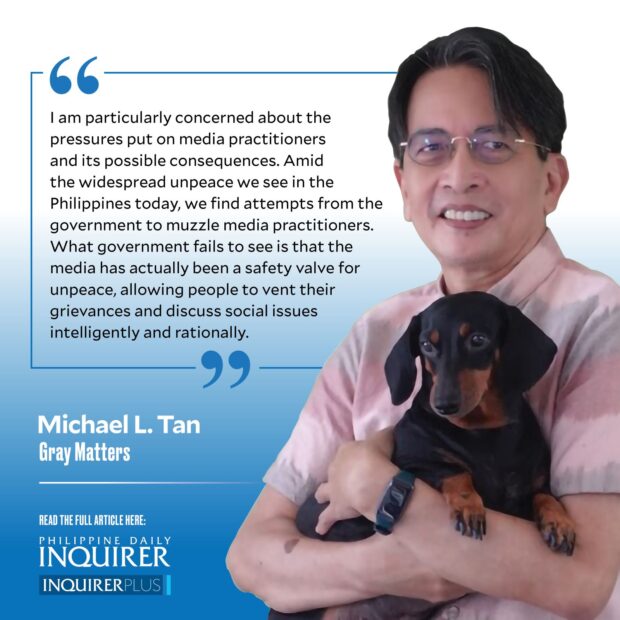Unpeace and freedom of information

Friends have been asking me to elaborate more on the concept of “unpeace,” which I used in my New Year column, “The power of good” (1/2/24).
Unpeace is a term that refers to a liminal (neither here, nor there) state where there may not be armed conflict even while there is serious unease and unrest that can lead to full-scale armed conflict.
The term has been used among theologians and religious groups for a number of years now. In the Philippines, I found at least two publications, both from the Protestants’ National Council of Churches in the Philippines (NCCP), that urge reflection on unpeace in our times, where violence is reconstructed to include hunger and unemployment to workers’ (and jeepney drivers?) unrest and even the cutthroat competition in business. Put another way, in one of the NCCP publications, unpeace refers to “attitudes and conditions of human behavior that disturbs, distorts, and devalue humans.”
Two fairly recent books have another take on unpeace. Oxford academic Lucas Kello wrote “The Virtual Weapon and International Order” in 2017, focusing on how rivalry among states now uses cyber technologies with very destructive effects.
“The Age of Unpeace,” a book by Mark Leonard, director of the think tank European Council on Foreign Relations, published in 2021, also looks at current information technologies, in particular social media, with concerns that they can be terribly destructive as well.
The irony is that these technologies connect people, but in a way that aggravates doubts and prejudices.
While all these warnings of unpeace may seem more appropriate for developed countries, I’ve thought about how the old and new converge to create even more risks for destructive conflicts in developing countries, including the Philippines.
Another way of looking at unpeace is to contrast the responses of the state during the Marcos martial law regime, with the use of brute force against critics and rebels, with the populist waves during the Duterte era and, today, Marcos Jr.’s presidency, where intimidation takes many forms that may be even more destructive than brute force, for example, the Red-tagging—accusations of critics as rebels—alternating between harassment and violence.
I am particularly concerned about the pressures put on media practitioners and its possible consequences. Amid the widespread unpeace we see in the Philippines today, we find attempts from the government to muzzle media practitioners.
What government fails to see is that the media has actually been a safety valve for unpeace, allowing people to vent their grievances and discuss social issues intelligently and rationally.
The hostile environment for media practitioners has made many reluctant to cover social issues and the unpeace that threatens to spill over into more confrontational conflicts.
Take hunger as an example of unpeace. We have the Social Weather Stations’ surveys of people’s own experiences of involuntary hunger (“In the last three months, did it happen even once that your family experienced hunger and not have anything to eat?”). The trends in the replies speak volumes of food insecurity in the country and potential civil unrest.
We need media to take off from these involuntary hunger statistics to describe the dimensions of food insecurity. I recently found two social science journal articles describing “pagpag” and “tirtir,” where poor families buy food discarded by fast-food chains and restaurants, which is then recooked and resold. I’ve known about pagpag for some time now but reading the journal accounts is still jarring, and we need media—print and broadcast—to develop these into stories, and commentaries, to jar our collective conscience.
Mind you, even developed countries now have food rescue programs, where surplus food production (e.g., milk, vegetables, meats) is purchased from farms and then transformed into gourmet foods.
Our pagpag is different, desperate attempts to survive, with all kinds of risks in terms of food safety. I am not advocating a crackdown on the practice; instead, we might look into the possibilities of a modified food rescue program.
But my point here is that food insecurity is a terrible unpeace and it is not just pagpag that needs to be publicized but all the other problems around food and nutrition, especially food production. Why are we now one of the world’s largest importers of rice? Why are vegetables and fruits rotting on farms?
I love our newspaper articles with restaurant reviews and featured recipes but shouldn’t we give the media more freedom to talk about hunger and the problems of our food producers, as well as the quality of the meals of the poor?
Without facts and truths in the print media, we shouldn’t be surprised that social media’s fake news and misinformation, as well as politicians’ promises around food (remember the famous election promise of rice at P20 a kilo?), take on so much credibility.
mtan@inquirer.com.ph
















